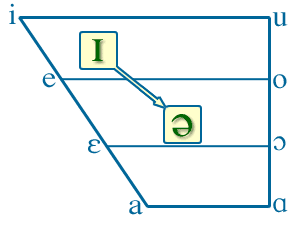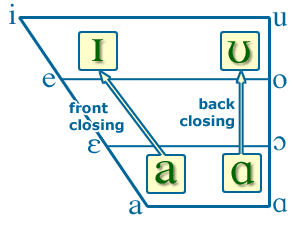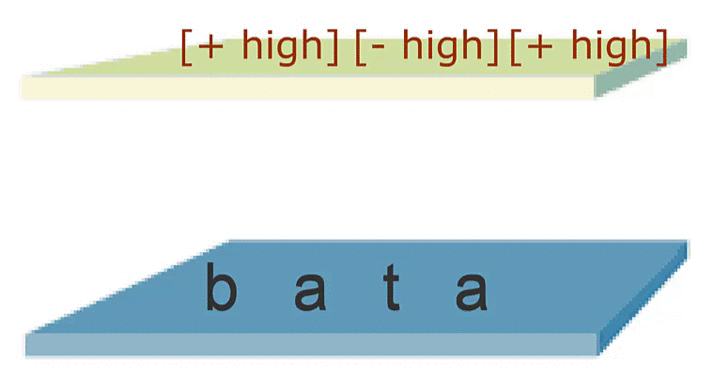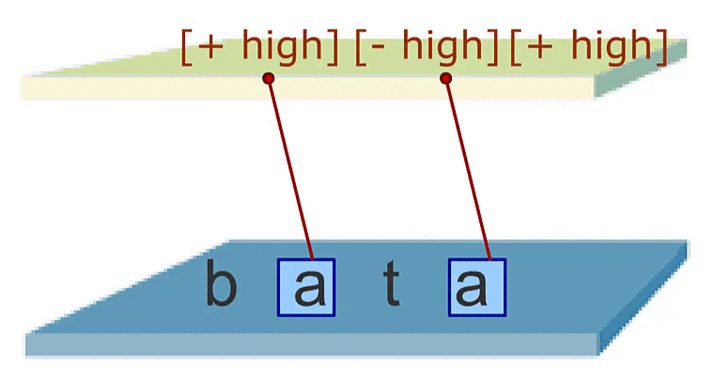Demo Glossary
This glossary is a fragment of the big VLC Glossary that hosts more than 1,000 entries. It hosts only those terms that are required for the demo-units of this demo course.
Special | A | B | C | D | E | F | G | H | I | J | K | L | M | N | O | P | Q | R | S | T | U | V | W | X | Y | Z | ALL
A |
|---|
C |
|---|
ChatGPT
(Generated by ChatGPT-3, 15 March 2023, post-edited by J. Handke) | |
D |
|---|
Diphthongs, Centering/InglidingDiphthongs are defined as centering or ingliding if a movement of the tongue from a peripheral to a central position occurs.
| |
Diphthongs, Closing/UpglidingDiphthongs are defined as closing or upgliding if a movement of the tongue from a low or central to a high (closed) position occurs. There are two variants of closing/upgliding diphthongs:
| |
G |
|---|
German, Standard (ISO-Code: DEU)The examples illustrate the synthetic fusional character of German. Furthermore, Standard German exhibits two word order patterns: SVO in main clauses and SOV in subordinate clauses:
| ||||||||||||||
J |
|---|
Japanese (ISO-Code: JPN)The examples below illustrate the strong agglutinating character of Japanese. Furthermore, it is obvious that Japanese exhibits a strict SOV order irrespective of the sentence type:
| ||||||||||||||
L |
|---|
Linear Ordering - Parameter Settings for PDE
Heads are in boldface, modifiers appear between square brackets [ ]. | ||||||
Low Back MergerIn Canadian and many regional variants in Northeast America, the phonemes /o/ and /oh/ have merged, so that cot and caught, Don and dawn, hock and hawk, collar and caller, are all homophones. This 'cot-caught merger' is complete in Canada, the West, Western Pennsylvania and Eastern New England. | ||
N |
|---|
NL-Phonology: The Dumping Principle
If after the application of mapping some tones are still free, they will be linked to the last vowel to the right. | |
NL-Phonology: The Mapping Principle
The mapping principle associates vowels with tones in a 1-to-1 fashion from left to right until we run out of vowels or of tones. | |
NL-Phonology: The No Crossing Principle
Association lines are not allowed to cross! | |
NL-Phonology: The Spreading Principle
If after the application of mapping some vowels are still free, they will be linked to the last tone on the right. | |
R |
|---|
Received Pronunciation

Received Pronunciation was originally defined as a regional standard associated with the south of England. Today, however, RP is merely an artificial construct which serves as a guideline for a socially more or less accepted standard of English, for example, the kind of English used by many BBC news readers. This variety had not received consideration at the outset. | ||
RhoticityIn 'rhotic' accents /r/ is overtly realized in a wide variety of phonetic contexts, including post-vocalic environments, such as farm /fahrm/ or far /fahr/. In the non-rhotic accents /r/ is excluded from post-vocalic environments, thus /fɑ:m/ and /fɑ:/. The rhotic accents include those typical of Scotland, Ireland, Canada, Barbados, certain western parts of England, and most of the United States, including General American. | |
S |
|---|
Several Illocutionary ActsThe utterance "I'll be there!" may realize any of the following illocutionary acts (besides many others), given an appropriate context:
| ||||||
Spanish, Castilian, Madrid (ISO-Code: SPA)
| ||||||||||||||
Staves and Lyrics
The autosegments are associated vertically across the tiers. Thus, this representation is similar to music where we the tune is given on one level and the text on another. | |
Structural AmbiguityStructural Ambiguity is basically a question of "what goes with what" in a sentence: it occurs when the constituents (i.e. the elements of sentence structure) can relate to each other in different ways, even though none of the individual words in the sentence may be ambiguous.
Here are two interpretations of the Noun Phrase [very old men and women] (pictured above, as 'interpretation 0') which can be represented using simplified constituent analysis:
NP[very old [men and women]] >> Both men and women are old.
NP[[very old men] and [women]] >> The men are old, the women can be of any age. | |
T |
|---|
The Levelt Maassen ExperimentThe Levelt-Maassen Experiment consists of a series of test where the movement of objects across a screen has to be described verbatim.
In tests 1 to 3 well-known objects (rectangle and triangle) move across the screen: In sequential movements (test 1 and test 2) we favour coordinate sentence structures, in simultaneous movements (test 3) we use NP-coordination. If an object's denomination is difficult to retrieve as in test in 4 (hexagon), we have to gain time and go back to sentence coordination, even if the movement occurs simultaneously. Thus, the retrieval of lexical items (i.e. phonetic planning) influences grammatical encoding. Levelt W.J.M/Maassen B. 1981. Lexical Search and Order of Mention in Sentence Production. In W. Klein/W.J.M. Levelt. (eds.). Crossing the boundaries in Linguistics. Dordrecht: Reidel. | |||||||
Turkish (ISO-Code: TUR)The examples illustrate the strong agglutinating character of Turkish. Furthermore, Turkish exhibits a strict SOV order irrespective of the sentence type:
| ||||||||||||||
V |
|---|
VLC-NavigationThere are several ways to navigate through the courses and the activities they contain. In addition to using the respective titles of the individual activities as hyperlinks, the textual content offers content-sensitive hyperlinks. The function of these hyperlinks is indicated by the cursor shape:
In some cases, the mouse symbol indicates that further information can be retrieved by moving the mouse cursor over an image or a text:
| ||||||||||||
W |
|---|
Welsh (ISO-Code: CYM)The examples illustrate the fusional character of Welsh. Furthermore, it is obvious that Welsh favors a VSO order but allows for other head-modifier patterns as well:
| ||||||||||||||












